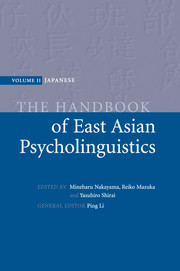Book contents
- Frontmatter
- Contents
- List of figures
- List of contributors
- In memory of Miwa Nishimura
- Preface
- Introduction
- Language acquisition
- Part II Language processing
- 26 The phonetic and phonological organization of speech in Japanese
- 27 Speech segmentation by Japanese listeners: its language-specificity and language-universality
- 28 Prosody in sentence processing
- 29 Speech errors
- 30 Effects of word properties on Japanese sentence processing
- 31 Orthographic processing
- 32 Lexical access
- 33 Incrementality in Japanese sentence processing
- 34 Processing alternative word orders in Japanese
- 35 Processing relative clauses in Japanese: coping with multiple ambiguities
- 36 Processing empty categories in Japanese
- 37 The difficulty of certain sentence constructions in comprehension
- 38 Reading and working memory
- 39 Sentence production in Japanese
- 40 The neural basis of syntactic processing in Japanese
- 41 The competition model
- 42 Connectionist models
- 43 Computational linguistics
- 44 Language and gesture as a single communicative system
- References
- Name index
- Subject index
44 - Language and gesture as a single communicative system
from Part II - Language processing
Published online by Cambridge University Press: 05 June 2012
- Frontmatter
- Contents
- List of figures
- List of contributors
- In memory of Miwa Nishimura
- Preface
- Introduction
- Language acquisition
- Part II Language processing
- 26 The phonetic and phonological organization of speech in Japanese
- 27 Speech segmentation by Japanese listeners: its language-specificity and language-universality
- 28 Prosody in sentence processing
- 29 Speech errors
- 30 Effects of word properties on Japanese sentence processing
- 31 Orthographic processing
- 32 Lexical access
- 33 Incrementality in Japanese sentence processing
- 34 Processing alternative word orders in Japanese
- 35 Processing relative clauses in Japanese: coping with multiple ambiguities
- 36 Processing empty categories in Japanese
- 37 The difficulty of certain sentence constructions in comprehension
- 38 Reading and working memory
- 39 Sentence production in Japanese
- 40 The neural basis of syntactic processing in Japanese
- 41 The competition model
- 42 Connectionist models
- 43 Computational linguistics
- 44 Language and gesture as a single communicative system
- References
- Name index
- Subject index
Summary
People often produce gestures while speaking. Speech–gesture research is one of the emerging fields in psycholinguistics that, by referring to speech-accompanying gestures, attempts to elucidate the underlying process in which qualitatively different types of thinking, e.g. imagistic thinking and linguistic thinking, become coordinated with one another. The question regarding the impact of one type of thinking on another, or rather the relation between the two, is not unique at all. In fact, it has been wrestled with over the years not only in psychology of language, but also in the other neighboring areas of study (e.g. Whorf, 1956; Vygotsky, 1986). In addition, studies of either speech or gesture alone are not new in the history of psychology, either. Gesture was indeed one of the topics of study for the founding fathers of psychology, such as Willem Wunt, as was speech for anyone studying language. What is unique in the speech–gesture study under review here is that the relation between the two is the topic of study. With speech and gesture as the “double windows” we hope the way in which different types of thinking underlie linguistic communication can be elucidated more fully than ever before (McNeill, 1992).
Typical questions addressed in speech–gesture studies include the following: what exactly is gesture and how is it different from speech? What is the relation between speech and gestures in timing? Do gestures facilitate speech? Do gestures help organize the discourse? Are gestures involved in language acquisition in children and/or in second language acquisition?
- Type
- Chapter
- Information
- The Handbook of East Asian Psycholinguistics , pp. 333 - 339Publisher: Cambridge University PressPrint publication year: 2006



